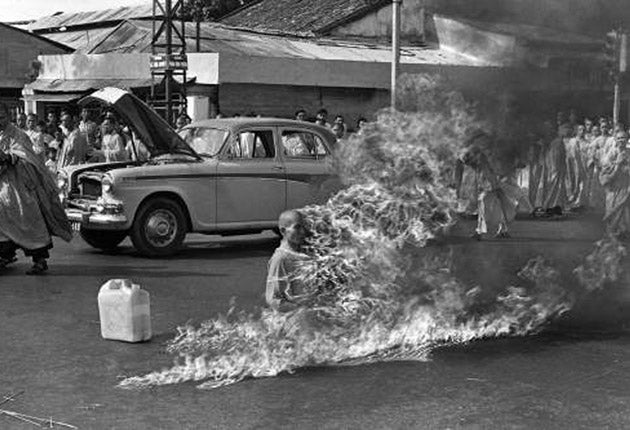The Timeline: Self-immolation

100BC: Religious sacrifice
In the Lotus Sutra, the doctrine upon which Mahayana Buddhism is founded, the bodhisattva Medicine King offers himself to Buddha by performing various acts of self-mutilation, including burning parts of his body.
The act became a template for subsequent acts of self-immolation; partial immolation was practiced by many early Buddhists and, in medieval China, immolation as suicide was established as a means of religious sacrifice.
AD900: Sati suicides
Deriving from the legend of the goddess Sati, who set herself alight in protest against the father's humiliation of her mortal husband Shiva, Sati sees widows cremate themselves along with their deceased husbands in an attempt to cast away their spouse's sins. By the 10th century AD, Sati was widespread across much of the Hindu East. It has been outlawed in India since 1829.
1600s: Religious revolt
In early modern Europe, self-immolation was employed as religious protest. During the Great Schism of the Russian Church, entire villages of liturgical Old Believers burned themselves to death in so-called "fire baptisms", while French Jesuits engaged in partial immolation to symbolise the suffering of Christ on the cross.
1960s: Political protest
During the Vietnam war, a number of Buddhist monks set themselves alight to protest against the treatment of the South Vietnamese Buddhists. The images – broadcast around the world – captured international attention, famously Thích Quang Ðuc's immolation in Saigon in June 1963.
Five years later, Ryszard Siwiec became the first person to burn themselves to death in response to the Soviet invasion of Czechoslovakia. Four months later, in January 1969, Czech student Jan Palach also set fire to himself in Prague's Wenceslas Square.
2010: Eastern Uprising
On 17 December 2010 Mohamed Bouazizi, a young Tunisian street vendor, had his wares confiscated by police claiming that he did not have a vendor's permit. For Bouazizi, it was the final straw; he set himself alight, and in doing so became a symbol of the repression endemic within his country. The act became a catalyst for protesters, who went on to force out President Zine El Abidine Ben Ali and thus spark the Arabic Revolutions of 2011.
Subscribe to Independent Premium to bookmark this article
Want to bookmark your favourite articles and stories to read or reference later? Start your Independent Premium subscription today.

Join our commenting forum
Join thought-provoking conversations, follow other Independent readers and see their replies